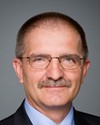Thank you. It's a pleasure to be here again.
What I thought we would do, based on the questions we heard last time and some of the uncertainties, is focus this short presentation on two areas. One is to give a little more detail about the tool box that we have at our disposal in the geosciences. The second is to go into a little more depth on the outputs we have, how we disseminate information and, within that, how we engage communities.
Let's look at page 2.
Each layer in the image to the right represents a specific type of dataset: bedrock geology, surficial geology, geophysics, geochemistry, geochronology, mineral showings, topography, satellite images, etc.
Note that the layers depicted here do not correlate with the depth below the surface, rather they are best thought of as tools in the geoscience toolbox. Consequently, depending on the type of problem that we are tackling, we will choose the appropriate series of tools from the toolbox. Data can be acquired remotely, for instance through satellite imagery, geophysical airborne surveys, by surveys in the field, or in the lab.
Today, in this presentation, we provide three examples, wherein three different tools are used.
The first example is on page 3. In the north, most of the bedrock is covered by glacial debris left behind 8,000 years ago; these are known as surficial deposits. In order to understand the geology of the rocks hidden beneath the till, we use geophysical surveys. In this slide, we have removed the surficial deposits—left image—to show you what the geophysical survey sees. Geophysical surveys provide us with physical properties of the rock, for example the magnetic field of the bedrock. Hidden mineral deposits can be detected through the glacial overburden, which may be as much as 100 metres thick. This allows geologists to trace units and produce interpretative maps, even when they can't see the rocks.
In summary, we use geophysics to provide an image of the bedrock and to highlight mineralized environments.
Turning to page 4, the second example, we have to recall that glacial ice up to two kilometres thick once covered this part of Canada during the last ice age. The glaciers ground up rock and material and distributed it across the land, as I explained with the previous slide. Buried deposits have halos or trails of mineral concentrations, sometimes kilometres long, that lead back to the source of the mineral.
Geochemical maps, shown in the image on the left, provide an indication of the types of mineral deposits to expect, and clues as to where to find them. Geochemical anomalies help identify prospective areas and possible mineral deposit types.
The third example is on page 5. Another tool in our tool box is geochronology, which deals with the age of the rock. We may identify the need to determine the age of certain rock units to understand the geological history of an area. With this understanding, we can formulate new hypotheses, and develop a new geological framework or frameworks. This helps focus exploration on the most prospective units.
The image on the top is a geological bedrock map identifying different geological units found on the Melville Peninsula in Nunavut. A grain of zircon is extracted from a rock unit, which is the middle left image. It is then analyzed with the sophisticated laboratory equipment that you see in the bottom photo.
One grain can yield a complex history, as we've tried to illustrate here. This is one grain. You can see, in this case, there are two different ages from two different geological events. These ages are depicted in millions of years. The outer part of the grain is 1.8 billion years old, and the internal grain is 2.5 billion years old.
This approach helps to pinpoint age of mineralization versus the age of the formation of the rock. Later, during the question session, our experts can get into why that's important. Information acquired through the various tools, such as these three I've just highlighted, are integrated to produce a final interpretation of the geology, including an assessment of prospective mineral environments and exploration potential.
Let us move on to page 6.
You will recall that at the last meeting, we talked about our outputs in the annex. The following slides highlight additional facts on GEM outputs.
GEM has conducted 24 geophysical surveys across the north, covering an area roughly equivalent to the size of Newfoundland, Labrador and Nova Scotia combined. The primary purpose of these maps is to help guide field mapping, by imaging major features. However, exploration companies also use this information directly to identify new targets.
Let's move on to page 7.
GEM's 424 publications are available free of charge to the public for download on NRCan's fully searchable GEOSCAN database. These files include geophysical surveys, geological maps, raw data and scientific articles which have been subject to the peer-review process.
The GEOSCAN database also includes metadata and abstracts for several of GEM's scientific and technical presentations. GEM researchers have made more than 284 presentations at industry oriented events. Examples of such events include the annual provincial and territorial open houses, such as the Yukon Geoscience Forum and the Nunavut Mining Symposium. Scientists have also made 93 scientific presentations at societies and scientific associations conferences such as the joint meeting of the Geological Association of Canada and Mineralogical Association of Canada or the American Geophysical Union annual meeting. They also supervised the 16 thesis publications which have already been produced by the program.
Finally, note that delivery strategies vary on a project to project basis.
Turning to page 8, the GEM technical information is being made available to local communities as well. For example, a web service tool is being developed by Arctic College in Iqaluit to make local geoscience accessible to northerners.
The Arctic College is using GEM Cumberland Peninsula information, and this is being done via a GEM grant that we have given Arctic College. This web service tool is being updated with new GEM data and information as it becomes available.
Moving on to page 9, all of this information is released to the public free, and it's accessible online. NRCan is recognized as a leader in open data, which is to make data available all for free. GEM is making all data, information, and knowledge available online at no fee, and through an unrestricted licence. This ensures a level playing field within industry and between industry and communities. Open access to our information is helping promote Canada's north to investors.
GEM publications can be discovered from more than one dissemination portal. I've already mentioned GEOSCAN, but there's also GeoPub, GeoRef, CrossRef, Google and Google Books. As well, there is an RSS news release function that can be subscribed to.
GEM also provides geoscience information to multiple stakeholders. We provided many examples, in our earlier presentation, of how GEM information supported industry decisions, but the same information can also help northerners make sound, sustainable economic decisions. What we've tried to illustrate in this slide of the surficial geology map is that it is not only important for the exploration industry to understand the underlying glacial history for the source of precious metals or diamonds, but it also can be used by land use planners to identify sources of aggregate or areas of permafrost sensitivity. In developing geological mapping, the open data is useful to not only the development industry but also to the planners of towns and territories and provinces.
Moving on to page 10, there are essentially three phases, if we could simplify, to our community engagement. We start at the beginning with letters, community meetings, and we acquire permits that are necessary. We meet with the Inuit, first nations, and Métis to acquire traditional knowledge. During the project, we hire field assistants whenever we can who are local. We hire wildlife monitors, as I discussed at our last meeting. We present public presentations and we develop, where feasible, field courses. In part three, the closure and beyond, we develop workshops, school presentations, we work with local levels of government, post-secondary institutions, and we transfer various sorts of knowledge.
The GEM program has developed its community engagement practices under the guidance of the advisory group of northerners that I mentioned at our last appearance. I remind you, this advisory group of northerners provides advice to the GEM program from a northern perspective regarding community engagement during project development, planning, delivery and communication of results thereafter. This advisory group of northerners includes representatives from aboriginal communities and associations, territorial governments, educational institutions, and northern exploration industry.
Moving on on to the final slide, page 11, I'd like to make three points here. First of all, with reference to the goals of the program, GEM has made notable progress in our first three and a half years. We are already seeing significant use by industry of GEM information. We're seeing new investment in the north, and some encouraging discoveries to date. Although not yet complete, the program—we feel—is on track to achieving the projected investment leverage.
Our second point here is that there is also evidence that GEM is achieving its goal of having communities use public geoscience information. The best example comes from the Cumberland project on Baffin Island, where the community has requested a short course on diamond prospecting and mining. Another example is a recent invitation to present at the annual Kivalliq regional mayors annual meeting to present GEM results in the Melville Peninsula area.
Finally, GEM is contributing to the training of the next generation of highly qualified geoscientists. At least 38 students are on their way to graduate degrees with northern research experience, and another 50 undergraduate students have also been trained. Early indications are that industry is welcoming these new young scientists into the workforce.
Mr. Chairman, this concludes my presentation. Thank you.






